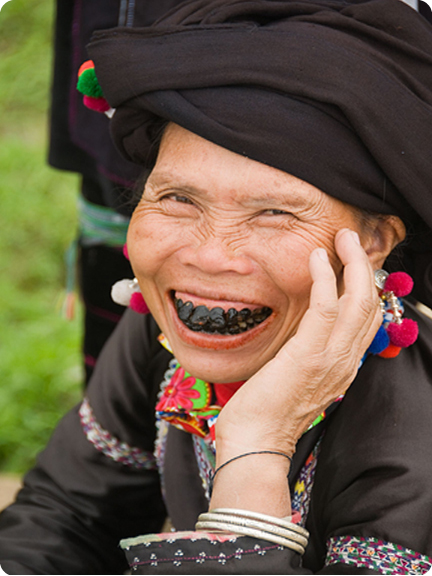Tailor Made Holidays with our travel experts
We'll do our best to call you within 48h

Among ethnic minorities, the most populated are Tay, Thai, Muong, Hoa, Khmer, Nung… with a population of around 1 million each, while the least populated are Brau, Roman, Odu with several hundred people each.
The Viet people succeeded in establishing a centralized monarchy right in the 10th century. The Cham people once boasted a flourishing culture early in the history. The Tay, Nung, and Khmer peoples had reached high levels of development with the presence of various social strata. The Muong, H’mong, Dao, Thai peoples… gathered under the rule of local tribal heads. Many ethnic groups divided their population into social echelons, especially those who lived in mountainous areas.
A number of ethnic minorities had mastered some farming techniques. They grew rice plants in swamped paddy fields and carried out irrigation. Others went hunting, fishing, collecting and lived a semi-nomadic life. Each group has its own culture, diverse and special. Beliefs and religions of the Vietnamese ethnic minority groups were also disparate from each other.
However, a fundamental solidarity among ethnic groups has been established on top of this difference as a result of a centuries long cooperation on the soil of Vietnam. Right in the first century of the history, a mutual supplement in economic relationship between lowland people and mountainous people was formed. This solidarity had been unceasingly strengthened during wars of resistance for defending the country. Through the shared struggle for defending and building of the country and the mutual assistance for co-existence and development, a common community between the Viet people and other ethnic minority peoples had been established and continuously consolidated and developed.
Nonetheless, an evident gap in the material and moral life has indeed still existed between peoples living in the deltas and those living in mountain areas as well as among ethnic minorities themselves. The Vietnamese government has worked out specific policies and special treatments in order to help mountainous people catching up with lowland people, and made great efforts to develop and preserve traditional cultural identities of each ethnic minority group. At present, the programs of providing iodized salt for remote villages, equipping villages health care and hygienic station, fighting malaria, building free schools for ethnic minority children, settled agriculture and fixed residence, and projects of creating new writing scripts for minority peoples and studying and developing traditional culture of each ethnic minority group… have obtained satisfactory results. For more infos, visit us here.
Tay Ethnic Minority in Ha Giang Vietnam
The Tay is the second large ethnic minority in Ha Giang, account for 25 percent total population of province. They mainly live on planting wet rice in fields near river, mountain foot and farming slope. Tay villages are usually at mountain foot and include about 15 to 20 houses. They live in house of stilt, thatch roofed houses using palm leaves or grass.
Their family handicraft is quite developed such as, knitting, making wooden furniture, pottery. Besides, weaving fabric of Tay is quite well known, especially, the type of blankets, brocade turbans with rich pattern which a lot of people love. Tay ethnic usually wear cotton clothes, dyed indigo, wear silver necklace and silver rings at their wrists and ankles. Their main color on costumes is indigo. The culture of Tay is very diversified with different kind of ceremory involving production, human life, wedding, funeral, new house celebration. The folkloric literature of Tay community are a rich treasure of legends, myths, ancient stories, verse stories, folkloric songs. Of which, Tay’s folkloric songs are well known for song “ glider”- this is a form of culture of the Vietnamese.
Dao ethnic minority
The Dao ethnic group in DVKP can be divided into sub-group such as Red Dao, Coin Dao, White Trousers Dao, Long Robe Dao (Dao áo dài), Lo River Dao (Dao lô giang) who live by slope and terrace farming. The Dao people have some unique handicraft making such as forging, casting, jewellery, embroidery and wax printing-dyeing clothes. They live in stilt, earth or half stilt-half earth houses, close to water sources. Their dresses usually show traditional features and designs using colour thread, with lots of turban, shirt, skirt types. Their traditional religious culture is very complex, demonstrating communal spirit, conscience and conception. Worshiping and wizardry are not simply superstition but something special indicating the depth of their culture. The Dao folkloric literature is very rich in legends, myths, narratic stories, pop songs, quizzes, proverbs implying their communal perception of the universe and human life.